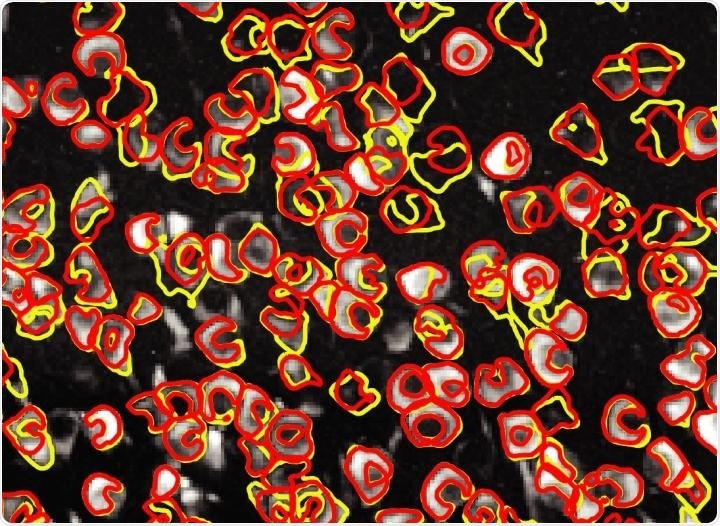Neuroscientists will no longer have to track neural activity by hand thanks to invaluable open-source software CaImAn, which automates the process with near-human accuracy.

This is an image of neurons (white) taken using calcium imaging techniques. An innovative software dubbed CaImAn can automatically differentiate between individual neurons (yellow outlines) with nearly the same accuracy as a human (red outlines). Credit: Giovannucci et al./eLife 2019
Tracking neural activity manually is a laborious process that sees some scientists gather up to one terabyte of data in an hour using calcium imaging. But in January, a paper published in eLife announced that software CaImAn (an abbreviation of calcium imaging analysis) could achieve near-human accuracy while automating the entire process.
One experimenter can fill up the largest commercially available hard drive in one day,”
Michael Häusser, a University College London neuroscientist.
Additionally, while at the Flatiron Institute in New York City, Dmitri Chklovskii, leader of the neuroscience group at the Center for Computational Biology (CCB) said that “people spent more time analyzing their data to extract activity traces than actually collecting it.”
But it isn’t only the volume of data that can overwhelm teams tracking neural activity. Identifying individual neurons can be a highly challenging process, with fluorescent signals from different neurons overlapping and confusing the process, along with movement from the brain tissue itself also making it difficult to track single neurons using calcium imaging.
Calcium imaging uses dye that binds to calcium ions that are responsible for activating neurons. When under ultraviolet light, the dye is illuminated. It is necessary for the dye to bind to a calcium ion to achieve fluorescence so that researchers can track neurons’ activity visually.
The latest version of CaImAn can be used on standard laptops and analyzes data in real time, allowing researchers to run experiments while carrying out analysis at the same time. The software utilizes a mix of standard computational methods and machine-learning techniques.
The study states that CaImAn “provides automatic and scalable methods to address problems common to pre-processing, including motion correction, neural activity identification, and registration across different sessions of data collection.” It also achieves all of this with “minimal user intervention”.
CaImAn’s accuracy was tested against a dataset generated by humans. Not only was the software proved to be almost as accurate as humans, it also proved to be much more efficient. This increased efficiency frees researchers up to adapt their experiments as they work, leading to improvements in studies investigating how specific groups of neurons contribute to different behaviors.
CaImAn also tackled the issue of standardizing image data analysis, with datasets often revealing variations between researchers.
Machine-learning-based tools were also developed using human-generated datasets as training. These datasets are available publicly to allow the wider research community to develop CaImAn further and make new tools.
More than 100 labs use the software, which has been freely available for a number of years. In an effort to better manage the incredibly large datasets produced by calcium imaging, Dmitri Chklovskii initiated the project, with Eftychios Pnevmatikakis and Andrea Giovannucci later leading the effort.
It was first developed by Pnevmatikakis while working as a postdoc in Liam Paninski’s lab at Columbia University.
Pnevmatikakis said:
“It was elegant mathematically and did a decent job, but we realized it didn’t generalize well to different datasets. We wanted to transform it into a software suit that the community can use.”
Joining the CCB neuroscience group for three years to develop the software further, Giovannucci said “existing analysis tools were not powerful enough to disentangle the activity of this population of neurons and implied that they were all doing the same thing.” He explained that the software’s algorithm “subtracts the background voices and focuses on a few.”
The software is suited to two-photon and one-photon imaging, and Duke University Neuroscientist John Pearson said his lab was “excited about being able to use a tool like this.”